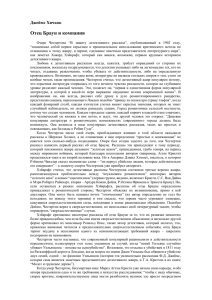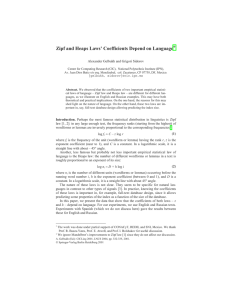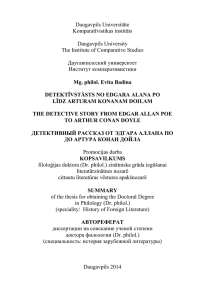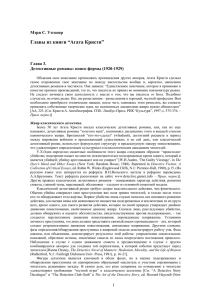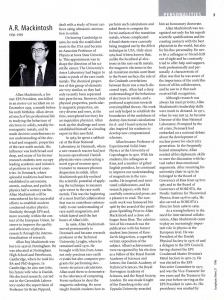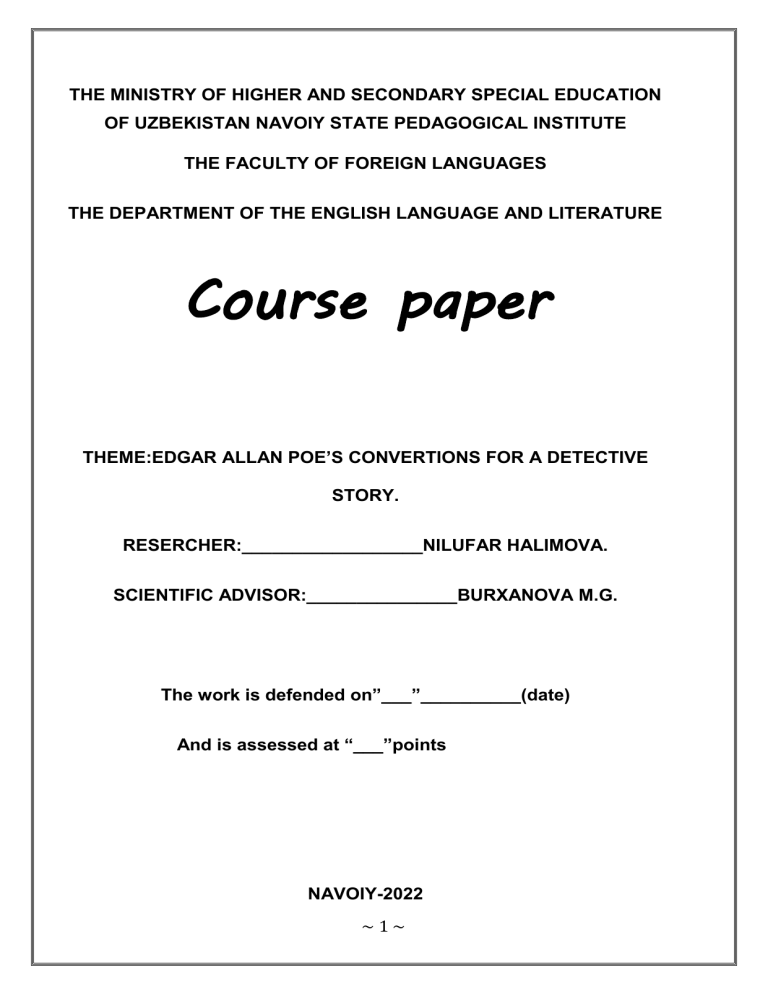
THE MINISTRY OF HIGHER AND SECONDARY SPECIAL EDUCATION OF UZBEKISTAN NAVOIY STATE PEDAGOGICAL INSTITUTE THE FACULTY OF FOREIGN LANGUAGES THE DEPARTMENT OF THE ENGLISH LANGUAGE AND LITERATURE Course paper THEME:EDGAR ALLAN POE’S CONVERTIONS FOR A DETECTIVE STORY. RESERCHER:__________________NILUFAR HALIMOVA. SCIENTIFIC ADVISOR:_______________BURXANOVA M.G. The work is defended on”___”__________(date) And is assessed at “___”points NAVOIY-2022 ~1~ Content Introduction……………………………………………………………3 Chapter I. The General overview of the American Literature of the first half of the XIX century. I.1American Revolution and its influence upon the literature……………………………………………………………….. 4 I.2 Outstanding authors of the first half of the XIX century………..6 Chapter II. Edgar Allan Poe as the creator of detective stories II.1 The definition of the “detective story”…………………………....10 II.2 Poe as the Father of Detective Fiction……………………………12 Chapter.III The most famous detective stories of the author III.1 “The Murders in the Rue Morgue”……………………………..15 III.2 "The Mystery of Marie Rogêt"…………………………………19 III.3 “The Purloined Letter”…………………………………………..21 Conclusion……………………………………………………………....24 References…………………………………………………………….....26 ~2~ American Introduction Edgar Allan Poe’s importance as a detective writer may be seen in his pioneering contributions to the genre, in the rich variety, meaning, and significance of his stories, and in their influence on writers the world over. And Poe’s character C. Auguste Dupin, a private detective, became the model for many later fictional detectives. Relevance of the study. The great contribution made by Edgar Allan Poe in the formation of American literature can not be overemphasized. Edgar Allan Poe is one of the first American detective writers, whose influence is be traced in American literature and European in modern times. His stories are read by children, probed with the tools of psychoanalysis by critics, and transformed into films. Therefore, his creative activity is worth of paying attention to and the given theme is actual for investigation. stories. The objects of study are Edgar Allan Poe’s detective Subject of research - characteristic features and artistic peculiarities of Poe’s detectives. The aim of work. To analyze Edgar Allan Poe’s detective stories; to investigate and to show their characteristic features artistic peculiarities. Research objectives. 1. To investigate American Literature of the first half of the XIX century and to allocate main authors of that time. fiction. 2. To consider Edgar Allan Poe as the creator of the detective 3. To analyze Edgar Allan Poe’s detective stories as the prototype for many future fictional detectives. The hypothesis of the study. Edgar Allan Poe deserves to be named “the father of the detective story”. He created so much that is of importance in the field – literally creating the template for all of detective fiction to follow. 1 1 Ackroyd, Peter. Poe, A Life Cut Short. Baltimore: Fishman Books, 1998 ~3~ Chapter 1. The General overview of the American Literature of the first half of the XIX century. I.1 American Revolution and its influence upon the American literature The hard-fought American Revolution against Britain (1775-1783) was the first modern war of liberation against a colonial power. The triumph of American independence seemed to many at the time a divine sign that America and her people were destined for greatness. Military victory fanned nationalistic hopes for a great new literature. Yet with the exception of outstanding political writing, few Revolution. works of note appeared during or soon after the American books were harshly reviewed in England. Americans were painfully aware of their excessive dependence on English literary models. The search for a native literature became a national obsession. As one American magazine editor wrote, around 1816, "Dependence is a state of degradation fraught with disgrace, and to be dependent on a foreign mind for what we can ourselves produce is to add to the crime of indolence the weakness of stupidity". Cultural revolutions, unlike military revolutions, cannot be successfully imposed but must grow from the soil of shared experience. Revolutions are expressions of the heart of the people; they grow gradually out of new sensibilities and wealth of experience. It would take 50 years of accumulated history for America to earn its cultural independence and to produce the first great generation of American writers: Washington Irving, James Fennimore Cooper, Ralph Waldo Emerson, Nathaniel Hawthorne, Edgar Allan Poe, Walt Whitman, and others. America's literary independence was slowed by a lingering identification with England, an excessive imitation of English or classical literary models, and difficult economic and political conditions that hampered publishing. ~4~ Revolutionary writers, despite their genuine patriotism, were of necessity self-conscious, and they could never find roots in their American sensibilities. Colonial writers of the revolutionary generation had been born English, had grown to maturity as English citizens, and had cultivated English modes of thought and English fashions in dress and behavior. Their parents and grandparents were English (or European), as were all their friends. Added to this, American awareness of literary fashion still lagged behind the English, and this time lag intensified American imitation. As if in response, four American authors of very respectable stature appeared: William Cullen Bryant, Washington Irving, James Fennimore Cooper, Edgar Allan Poe. They wrote in many prose genres, initiated new forms, and found new ways to make a living through literature. With them, American literature began to be read and appreciated in the United States and abroad. 2 2 Bailyn, Bernard. The Ideological Origins of the American Revolution. 1992, - p. 298 ~5~ I.2 Outstanding authors of the first half of the XIX century After the American Revolution, and increasingly after the War of 1812, American writers were exhorted to produce a literature that was truly native. William Cullen Bryant, Washington Irving, James Fennimore Cooper, and Edgar Allan Poe initiated a great half century of literary development. Irving, often considered the first writer to develop a unique American style [citation needed] (although this has been debated) wrote humorous works in Salmagundi and the well-known satire A History of New York, by Diedrich Knickerbocker (1809). Bryant wrote early romantic and nature-inspired poetry, which evolved away from their European origins. In 1832, Poe began writing short stories – including "The Masque of the Red Death", "The Pit and the Pendulum", "The Fall of the House of Usher", and "The Murders in the Rue Morgue" – that explore previously hidden levels of human psychology and push the boundaries of fiction toward mystery and fantasy. Cooper's Leatherstocking Tales about Natty Bumppo (which includes The Last of the Mohicans) were popular both in the new country and abroad. Bryant, a New Englander by birth, attracted attention in his 23rd year when the first version of his poem "Thanatopsis" (1817) appeared. This, as well as some later poems, was written under the influence of English 18th-century poets. Still later, however, under the influence of Wordsworth and other Romantics, he wrote nature lyrics that vividly represented the New England scene. Turning to journalism, he had a long career as a fighting liberal editor of The Evening Post. He himself was overshadowed, in renown Irving. at least, by a native-born New Yorker, Washington Irving, youngest member of a prosperous merchant family, joined with ebullient young men of the town in producing the Salmagundi papers (1807-08), which took off the foibles of Manhattan's citizenry. This was followed by A History of New York (1809), by "Diedrich Knickerbocker", a burlesque history that mocked pedantic scholarship and sniped at the Old Dutch ~6~ families. Irving's models in these works were obviously Neoclassical English satirists, from whom he had learned to write in a polished, bright style. Later, having met Sir Walter Scott and having become acquainted with imaginative German literature, he introduced a new Romantic note in The Sketch Book (1819-20), Bracebridge Hall (1822), and other works. He was the first American writer to win the ungrudging (if somewhat surprised) respect of British critics. No writer was as successful as Irving at humanizing the land, endowing it with a name and a face and a set of legends. The story of "Rip Van Winkle", who slept for 20 years, waking to find the colonies had become independent, eventually became folklore. It was adapted for the stage, went into the oral tradition, and was gradually accepted as authentic American legend by generations of Americans. Irving discovered and helped satisfy the raw new nation's sense of history. His numerous works may be seen as his devoted attempts to build the new nation's soul by recreating history and giving it living, breathing, imaginative life. For subjects, he chose the most dramatic aspects of American history: the discovery of the New World, the first president and national hero, and the westward exploration. His earliest work was a sparkling, satirical History of New York (1809) under the Dutch, ostensibly written by Diedrich Knickerbocker (hence the name of Irving's friends and New York writers of the day, the "Knickerbocker School"). James Fennimore Cooper won even wider fame. Following the pattern of Sir Walter Scott's "Waverley" novels, he did his best work in the "Leatherstocking tales" (182341), a five-volume series celebrating the career of a great frontiersman named Natty Bumppo. His skill in weaving history into inventive plots and in characterizing his compatriots brought him acclaim not only in America and England but on the continent of Europe as well. James Fenimore Cooper, like Irving, evoked a sense of the past and gave it a local habitation and a name. In Cooper, though, one finds the powerful myth of a golden age and the poignance of its loss. While Irving and other American writers before and after ~7~ him scoured Europe in search of its legends, castles, and great themes, Cooper grasped the essential myth of America: that it was timeless, like the wilderness. American history was a trespass on the eternal; European history in America was a reenactment of the fall in the Garden of Eden. The cyclical realm of nature was glimpsed only in the act of destroying it: The wilderness disappeared in front of American eyes, vanishing before the oncoming pioneers like a mirage. This is Cooper's basic tragic vision of the ironic destruction of the wilderness, the new Eden that had attracted the colonists in the first place. Cooper accepted the American condition while Irving did not. Irving addressed the American setting as a European might have -- by importing and adapting European legends, culture, and history. Cooper took the process a step farther. He created American settings and new, distinctively American characters and themes. He was the first to sound the recurring tragic note in American fiction. Edgar Allan Poe, reared in the South, lived and worked as an author and editor in Baltimore, Philadelphia, Richmond, and New York City. His work was shaped largely by analytical skill that showed clearly in his role as an editor: time after time he gauged the taste of readers so accurately that circulation figures of magazines under his direction soared impressively. It showed itself in his critical essays, wherein he lucidly explained and logically applied his criteria. His gothic tales of terror were written in accordance with his findings when he studied the most popular magazines of the day. His masterpieces of terror: "The Fall of the House of Usher" (1839), "The Masque of the Red Death" (1842), "The Cask of Amontillado" (1846), and others – were written according to a carefully worked out psychological method. So were his detective stories, such as "The Murders in the Rue Morgue" (1841), which historians credited as the first of the genre. As a poet, he achieved fame with "The Raven" (1845). His work, especially his critical writings and carefully crafted poems, had perhaps a greater influence in France, where they were translated by Charles Baudelaire, than in his own country. ~8~ Poe believed that 3 strangeness was an essential ingredient of beauty, and his writing is often exotic. His stories and poems are populated with doomed, introspective aristocrats (Poe, like many other southerners, cherished an aristocratic ideal). These gloomy characters never seem to work or socialize; instead they bury themselves in dark, moldering castles symbolically decorated with bizarre rugs and draperies that hide the real world of sun, windows, walls, and floors. The hidden rooms reveal ancient libraries, strange art works, and eclectic oriental objects. The aristocrats play musical instruments or read ancient books while they brood on tragedies, often the deaths of loved ones. Themes of death-in-life, especially being buried alive or returning like a vampire from the grave, appear in many of his works, including "The Premature Burial," "Ligeia," "The Cask of Amontillado," and "The Fall of the House of Usher." Poe's twilight realm between life and death and his gaudy, Gothic settings are not merely decorative. They reflect the overcivilized yet deathly interior of his characters disturbed psyches. They are symbolic expressions of the unconscious, and thus are central to 3 his Bailyn, Bernard. The Ideological Origins of the American Revolution. 1992, - p. 298 ~9~ art. Chapter 2. Edgar Allan Poe as the creator of detective stories II.1 The definition of the “detective story” Detective story – is a type of mystery story that features a private detective or a police officer as the prime solver of a crime — usually a murder case. The detective is the main protagonist, through whom the story is told either as a first-person narrator or in the third person as portrayed by the author. The detective interrogates the suspects, ferrets out the clues, and tracks down the murderer. To play fair, the detective shares all the clues with the reader but withholds their significance until the end. The thrust of the detective’s investigation is based on motive, opportunity, and means, and he or she arrives at the solution by eliminating those suspects who do not fulfill these criteria. To make the case difficult for the detective and interesting to the reader, the author puts complications in the detective’s way: several suspects, additional murders, red herrings, and, often, threats of violence. Only at the end does the detective unmask the culprit, explain the plot, and present the deductive reasoning that he used in solving the case. The detective story, often called a whodunit, did not spring into being in this form. Rather, it evolved, early in the 20th century, from stories about detectives in which the reader was not a participant, but a witness, so to speak, looking over the detective’s shoulder. of the detective story are: The traditional elements (1) the seemingly perfect crime; accused suspect at whom circumstantial evidence points; dim-witted police; of the detective; (2) the wrongly (3) the bungling of (4) the greater powers of observation and superior mind (5) the startling and unexpected denouement, in which the detective reveals how the identity of the culprit was ascertained. Detective story frequently operate on the principle that superficially convincing evidence is ultimately irrelevant. Usually it is also axiomatic that the clues from which a logical solution to the problem can be reached be fairly presented to the reader at exactly the same time that the sleuth receives them and that the sleuth deduce ~ 10 ~ the solution to the puzzle from a logical interpretation of these clues. The first detective story was “The Murders in the Rue Morgue” by Edgar Allan Poe, published in April 1841. Poe's fictional French detective, C. Auguste Dupin, appeared in two other stories, “The Mystery of Marie Roget” (1845) and “The Purloined Letter” (1845). The detective story soon expanded to novel length.4 4 Encyclopedia of southern culture. University of North Carolina Press. 1989. ~ 11 ~ II.2 Poe as the Father of Detective Fiction E. A. Poe became the father of modern day detective stories by introducing Dupin in "The Murders in the Rue Morgue" as the first detective to use analytical and imaginative reasoning to solve the mystery and will create a guideline for all detective stories to come. The word "detective" was not in existence until Poe's writings. Mysteries had existed but never such a story that used a "detector" or placed such emphasis upon analysis versus trial and error. The vivid painting of the scene of the crime as well as the crime itself was likewise never done in writings until Poe. Dupin made his born in April 1841, when Graham’s Magazine published Poe’s classic horror story “The Murders in the Rue Morgue”. The detective appeared thereafter in “The Mystery of Marie Rogêt” (1842–43), “The Purloined Letter” (1845). In just three stories, Poe created the amateur detective and his narrator friend, the locked-room mystery, the talented but eccentric amateur sleuth outwitting the official police force, what Haycraft calls the "catalogue of minutia," interviews with witnesses, the first fictional case of an animal committing a perceived murder, the first armchair detective, the first fictional case which claimed to solve a real murder mystery previously unsolved by police, the concept of hiding something in plain sight so that it is overlooked by everyone who is searching for it, scattering of false clues by the criminal, accusing someone unjustly, the concept of "ratiocination", solution and explanation by the detective, and more. Other stories by Poe introduced cryptic ciphers, surveillance, the least-likely person theme (in one case, the narrator of the story is the murderer!), and other ingredients that have spiced up many a recipe for a crime story. Poe introduces one of the most basic elements of the detective story, which is the presentation of clues for his readers. This idea becomes very important in all subsequent works of detective fiction. That is, in all such fiction, all of the clues are available for the reader and the detective to solve the ~ 12 ~ crime (usually murder), and at the end of the story, the reader should be able to look back on the clues and realize that he could have solved the mystery. A detective story in which the solution is suddenly revealed to the reader in considered bad form. Poe was a man so devoted to concealment and deception and unraveling and detection that it was only natural for it to be displayed in his writings. He managed to manipulate setting, character, and dialogue to lead the reader inescapably to the emotional state most appropriate for the perfect murder. Poe does not allow the reader to merely sit back and observe, but makes the reader accompany the detective toward the solution and apply his own powers of logic and deduction alongside those of the detective. Although a crime usually has been committed, the reader's attention is diverted to the baffling circumstances surrounding the crime rather than to the event itself. The tale's climax is the solution of the puzzle, and the bulk of the narrative concerns the logical process by which the investigator follows a series of clues to this solution. Very often the "detective" solves the mystery by means of deductive reasoning from facts known both to the character and the reader. Poe wrote short narratives in which he originated almost every significant principle used by detective story writers for more than a century afterward. He called them "tales of ratiocination" (reasoning). Sir Arthur Conan Doyle and Dorothy L. Sayers have placed Poe at the beginning of the tradition of detective fiction. They believe he used numerous conventions of the genre, in particular the "armchair detective" and sidekick/narrator to serve as an intermediary between the detective and reader. Poe mediates between reader and detective, presenting what information he has to the reader, while allowing the detective to keep certain information and interpretations to himself. This technique has since been employed by numerous writers of detective fiction, the most famous being the Sherlock Holmes and Dr. Watson combination. Because it was Poe's first "tale of ratiocination", "The Murders in the Rue Morgue" introduces more basic ~ 13 ~ 5 features of detective fiction than any of Poe's other short stories. Among these basic features are three central ideas the murder occurs in a locked room from which there is no apparent outlet. The police are completely baffled as to how the murderer has escaped, because the doors were locked from the inside with the key inside with the victim, the windows apparently nailed shut, and the chimney blocked by one of the victims' bodies;motive, access, and other surface evidence points to an innocent person. Frequently in detective fiction, the amateur detective is drawn into the case because a friend or acquaintance has been falsely accused, as is Adolphe Le Bon, who "once rendered me a service for which I am not ungrateful". Thus, M. Dupin is drawn into the case because of an obligation to the accused.the detective uses some sort of unexpected means to produce the solution. One basic appeal of detective fiction lies in the unexpected solution, which becomes logical only in retrospect. Poe also began the tradition so fondly embraced by connoisseurs of crime fiction – what became known as "The Rules of the Game", which state, among other things: fair. (1) The detective story must play (2) The detective story must be readable. The detective story emerged from Poe’s long-standing interest in mind games, puzzles, and secret codes called cryptographs, which Poe regularly published and decoded in the pages of the Southern Literary Messenger. He would dare his readers to submit a code he could not decipher. More commonly, though, Poe created fake personalities who would send in puzzles that he solved. Dupin becomes a standin for Poe, who constructs and solves an elaborate cryptograph in the form of a bizarre murder case. Poe’s greatest contribution can be proved by the words of one of his famous follower – Arthur Conan Doyle: "Edgar Allan Рое was the 5 Poe, Adgar Allan. Tales of Mystery and Imagination. London: Edited by J. M. Dent & Sons. 1912 . ~ 14 ~ father of the detective tale, and covered its limits so completely that I fail to see how his followers can find any fresh ground which they can confidently call their own. For the secret of the thinness and also of the intensity of the detective story is that the writer is left with only one quality, that of intellectual acuteness, with which to endow his hero. Everything else is outside the picture and weakens the effect. The problem and its solution must form the theme, and the character – drawing is limited and subordinate. On this narrow path the writer must walk, and he sees the footmarks of Рое always in front of him ". Literary critic and writer Vincent Buranelli said next about Edgar Poe: "With “The Murders in the Rue Morgue” Рое became the only American ever to invent a form of literature. He invented the detective story. He also perfected it". "Take, again, the marvelous train of analytical reasoning whereby he arrives at truth in the “Rue Morgue”, a tale wherein the horror of the incidents is overborne by the acuteness of the arguments; and is introduced by a specimen of mind-reading...» These words belong to English writer and poet Martin Farquhar Tupper. From all mentioned facts we can definitely say, that Edgar Allan Poe deserves to be named “the father of the detective story”, and his contribution into the formation of American literature can not be overemphasized. He created so much that is of importance in the field – literally creating the template for all of detective fiction to follow.6 6 The New Encyclopaedia Britannica. Encyclopedia Britannica, Inc. 2005, - p. 2659. ~ 15 ~ Chapter.3 The most famous detective stories of the author III.1 “The Murders in the Rue Morgue” When first published in 1841, "The Murders in the Rue Morgue" was not "typical" Edgar Allan Poe. Gaining momentum as a Gothic horror writer, Poe had already penned "The Fall of the House of Usher" and several poems before "The Murders in the Rue Morgue" came to be. The latter work, however, proved that the author was so much more than a horror specialist. In fact, "Rue Morgue" was the first of three Poe tales that warrant his distinction as the father of detective fiction and the modern-day mystery. For what would be his first detective story, "The Murders in the Rue Morgue", Poe created Monsieur C. Auguste Dupin. Often credited as the "first-ever fictional detective", Dupin is an analytical and frightfully perceptive amateur private investigator. He earns the "detective" distinction if not in title than through his process. Poe's so-called "detective", C. Auguste Dupin is not much more than an unemployed philosopher with keen gifts of observation and rational assumption. Dupin earns his private investigator status through sheer curiosity. As a member of a once wealthy family that "by a variety of untoward events" has lost its wealth and, thus, its status, Dupin (though certainly not destitute) retreats from Parisian society. He hides away, collecting rare books, until a chance meeting with the unnamed narrator starts a firm friendship. It is here that "The Murders in the Rue Morgue" and, hence, Dupin's legacy begin. Together, the unnamed narrator and Dupin spend most their time reading or analyzing the world they have shut out. However, when a newspaper chronicles the unsolved murders of Madame L'Espanaye and her daughter, Dupin's intellectual mind cannot resist the challenge presented by them. Further, Dupin's acquaintance has been imprisoned for the crimes. With no experience in crime solving or police work, Dupin offers his services to the local police prefect for the sake of his own amusement, confident in his ability to deduct what the police could not. ~ 16 ~ Dupin begins his investigation with a thorough review of the Gazette des Tribunaux, a Parisian newspaper. From it, he learns the location and condition of the bodies as well as the extent of the police's investigation. The newspaper also discloses that several witnesses rushed to the scene upon hearing shrieks from inside Madame L'Espanaye's home. Each witness gives an account of what he or she saw and heard. Upon prying open the gate, they rushed in, but the screaming had already stopped. As they climbed the stairs, many of the witnesses heard two voices arguing. They agree that one voice was that of a Frenchman, but no two witnesses agree as to the language of the second voice. With the prefect's consent, Dupin and the narrator head to L'Espanaye's home in the Rue Morgue. From a detailed review of the crime scene, Dupin determines the manner of entry and the methodology of the killer. Finding non-human hair and noting the superhuman strength necessary to achieve the homicides and, in particular, the concealment of the Mademoiselle L'Espanaye's corpse, Dupin confirms his suspicions — that the murderer is not human! Surmising the culprit to be an "Ourang-Outang of the East Indian Islands" (presumably an orangutan), Dupin places an advertisement in a local newspaper to effectuate the return of the animal to its owner. When the owner comes looking for the beast, Dupin is ready with gun in hand. Thus confronted, the owner confesses the animal's crimes. Is C. Auguste Dupin truly a genius? Poe, through Dupin, is quick to criticize the investigatory techniques and mental acumen of the Paris police force. However, what inner-city Paris police officer, or any city officer for that matter, would suspect a large Asian primate running loose in a European city? Not to mention, it's 19th century Paris! The police don't exactly have high-tech lab equipment and DNA samples to work with. With that said, Dupin is able to solve the crime where others ~ 17 ~ cannot. He does so through thorough observation, deductive reasoning, and logical assumption, even if that logical assumption results in the conclusion that an orange monkey is terrorizing his not-so-beloved Paris.7 Thus, Dupin is literature's first "detective". With "The Murders in the Rue Morgue", fiction gained a new genre, the detective story. Poe continued the genre with two later C. Auguste Dupin tales, "The Mystery of Marie Roget" and "The Purloined Letter". 7 The New Encyclopaedia Britannica. Encyclopedia Britannica, Inc. 2005, - p. 2659. ~ 18 ~ III.2 "The Mystery of Marie Rogêt" With the success of "The Murders in the Rue Morgue", C. Auguste Dupin was destined to return. In his 1842 short story, "The Mystery of Marie Rogêt", Poe refuses to give his audience something that merely copies Rue Morgue. The only constants between it and the earlier Dupin tale are the reasoning and rational assumption abilities (what Poe called "ratiocination") of Dupin himself and the storytelling ability of an unnamed narrator sidekick In his second try at mystery writing, Poe focuses almost entirely on Dupin's reasoning skills, so much so that the solving of the murder loses all its importance. The setting of "The Mystery of Marie Rogêt", like that of "The Murders in the Rue Morgue", is Paris. But in few ways are the stories structurally comparable. "The Mystery of Marie Rogêt" begins sometime after the murders in the Rue Morgue. Dupin's credentials as a problem solver is now well established. Here, he invokes logic to unravel the mystery surrounding the brutal murder of a young perfume saleswoman, Marie Rogêt, Marie's body has been found floating in a river, and her apparent murder has gone weeks unsolved. Speculation on motives and culprits is plentiful, with the majority view being that she was overcome by a murderous gang. "The Mystery of Marie Rogêt" is limited to a single setting detached from the scene of the offense. In the company of the narrator, Dupin reads several newspaper articles pertaining to the murder and explains his conclusions to his friend. Unlike "Rue Morgue", Dupin does not visit the crime scene, examine evidence, or exert himself in capturing its perpetrator. Upon scrutinizing the articles, Dupin solves the crime to the point of knowing how to find the murderer but without actually learning his identity. He explains to the unnamed narrator the falseness of particular theories and witness statements. In doing so, he often makes assumptions the reader must accept as learned but that are often nearly as conjectural as those of the journalists and law enforcement officers he criticizes. In the end, Dupin ~ 19 ~ constructs the method for discovering Marie's killer, but he does not employ it. The killer himself is not captured within the confines of Poe's tale. In stark contrast to "The Murders in the Rue Morgue", C. Auguste Dupin is not met with an extraordinary or fantastical crime to solve. He also is not privy to entirely true (though not always correctly comprehending) witness accounts of the circumstances. Instead, Dupin must wade through false assumptions and irrational conclusions in order to decipher the truth. The murder is common in its elements, yet unsolvable, and all too real. Much like Law & Order and other crime dramas often tote their episodes as "ripped from the headlines", Poe fictionalized the real-life, New York murder of Mary Rogers, even quoting heavily from actual newspaper articles concerning Rogers' death. Through reasoning, which at times seems a lot like educated guessing, Dupin is able to solve the crime. However, Dupin's analysis reads more like a lecture than a detective story, void of any tension or climax. Reviving C. Auguste Dupin for a third and final story, "The Purloined Letter", Poe would give new dimension to his crafty logician. 8 8 The New Encyclopaedia Britannica. Encyclopedia Britannica, Inc. 2005, - p. 2659. ~ 20 ~ III.3 “The Purloined Letter” In "The Purloined Letter", there are no murders to be solved, nothing extraordinary to behold, and no complexity to the problem Dupin is called upon to solve. However, the beauty of the tale is in its simplicity. "The Purloined Letter," of course, begins with a crime. But the crime is as basic as the story's name explicitly states — a stolen letter, one of royal significance. The culprit of the crime is known to all. To simplify things further, the location where the letter is concealed is also known. Dupin's sole quest is to find where on the premises the letter is hidden and secure it before its contents can be used for blackmail. By merely placing himself in the shoes (and mind) of the crafty criminal, Dupin speedily surmises that the letter must be hidden in plain sight — hidden in such a way that intense scrutiny, such as that employed by the police, would cause the searcher to overlook or disregard the letter. Gaining entry into the blackmailer's home under false pretenses, Dupin spots the letter and replaces it with a fake. He returns it the police for a large reward So Dupin steals a letter from the thief who stole it in the first place. What's as great about so simple a story as "The Purloined Letter"? When playing Texas Hold-Em, good players play their opponents, not their cards. Being able to anticipate what a player will do based on past hands, body language, and whatever else one can devise about the personality of his/her opponent separates the winners from the losers. Likewise, the genius of "The Purloined Letter" is that Dupin goes beyond analysis of the evidence, testimony, and crime scenes as in Poe's two earlier stories to attempt to think like his adversary. He sums up all he knows about the thief, weighing such personality traits as his intelligence, his egotism, and his audaciousness. To outwit the thief, Dupin has to think like the thief. A short, crisp tale, "The Purloined Letter" isn't as fantastical as "The Murders in the Rue Morgue", nor is it as endless and anti-climatic as "The Mystery of Marie Rogêt". Instead, it offers another dimension to Poe's eccentric ~ 21 ~ logician, C. Auguste Dupin, a character who continues to serve as the prototypical detective .Edgar Allan Poe’s contribution into the further development of the detective tradition Contributing greatly to the genres of horror and science fiction, Poe is now considered as the father of the modern detective story and highly lauded as a poet. Walt Whitman, in his essay titled “Edgar Poe’s Significance” wrote: «Poe’s verses illustrate an intense faculty for technical and abstract beauty, with the rhyming art to excess, an incorrigible propensity toward nocturnal themes, a demoniac undertone behind every page. … » Poe was one of the first to shift the focus of mystery stories from the aesthetics of the situation to a more intellectual reality, moving the story from "a focus on the superficial trappings of eerie setting and shocking event to a study of the criminal's mind". Poe’s "The Murders in the Rue Morgue” changed the history of world literature. Often cited as the first detective fiction story, the character of Dupin became the prototype for many future fictional detectives, including Arthur Conan Doyle's Sherlock Holmes and Agatha Christie's Hercule Poirot. Once Sir Arthur Conan Doyle said, "Each [of Poe's detective stories] is a root from which a whole literature has developed.... Where was the detective story until Poe breathed the breath of life into it?" The new genre, created by Poe is distinctive from a general mystery story in that the focus is on analysis. The story also established many tropes that would become common elements in mystery fiction: the eccentric but brilliant detective, the bumbling constabulary, the first-person narration by a close personal friend. Poe also portrays the police in an unsympathetic manner as a sort of foil to the detective. Poe also initiates the storytelling device where the detective announces his solution and then explains the reasoning leading up to it. It is also the first locked room mystery. The popularity of these tales Poe attributed to their being "something in a new key .... people think they are more ingenious than they are – on account of their method and air of method. In the 'Murders in the Rue ~ 22 ~ Morgue,' for instance, where is the ingenuity of unraveling a web which you yourself (the author) have woven for the express purpose of unraveling". The importance of Edgar Allan Poe to American Literature should not be underestimated. In modern times, everything from Agatha Christie to "Murder She Wrote" finds its roots in Poe's detective stories. Edgar Allan Poe’s importance as a detective writer may be seen in his pioneering contributions to the genre, in the rich variety, meaning, and significance of his stories, and in their influence on writers the world over. And Poe’s character C. Auguste Dupin, a private detective, became the model for many later fictional detectives. 9 9 The New Encyclopaedia Britannica. Encyclopedia Britannica, Inc. 2005, - p. 2659. ~ 23 ~ Conclusion The first true detective stories were written by Edgar Allan Poe. Many writers and critics have plainly stated that he is the inventor of detective fiction. Poe introduces one of the most basic elements of the detective story, which is the presentation of clues for his readers. This idea becomes very important in all subsequent works of detective fiction. That is, in all such fiction, all of the clues are available for the reader and the detective to solve the crime (usually murder), and at the end of the story, the reader should be able to look back on the clues and realize that he could have solved the mystery. A detective story in which the solution is suddenly revealed to the reader in considered bad form. Poe was a man so devoted to concealment and deception and unraveling and detection that it was only natural for it to be displayed in his writings. Poe did not write any detective novels, just short stories that later on became the most influential pieces of work for the detective story genre. E. A. Poe became the father of modern day detective stories by introducing Dupin in "The Murders in the Rue Morgue" as the first detective to use analytical and imaginative reasoning to solve the mystery. "Rue Morgue" was the first of three Poe tales that warrant his distinction as the father of detective fiction and the modern-day mystery. The detective appeared thereafter in “The Mystery of Marie Rogêt” (1842–43), “The Purloined Letter” (1845). In just three stories, Poe created the amateur detective and his narrator friend, the locked-room mystery, the talented but eccentric amateur sleuth outwitting the official police force, what Haycraft calls the "catalogue of minutia", interviews with witnesses, the first fictional case of an animal committing a perceived murder, the first armchair detective, the first fictional case which claimed to solve a real murder mystery previously unsolved by police, the concept of hiding something in plain sight so that it is overlooked by everyone who is searching for it, scattering of false clues by the criminal, accusing someone unjustly, the concept of "ratiocination", ~ 24 ~ solution and explanation by the detective, and more. Poe was famous for his brilliant and eccentric amateur style. Poe chose to make his stories as realistic as he could provide a fascinating and exciting plot. Many authors have tried to copy the same structure and plots of Poe, but not many have been able to succeed. Exciting and fascinating plots are hard to compose. Poe made it look easy to write such detailed and deep stories. Poe had an ability that allowed him to describe a fictional scene so detailed and real it was hard not to believe that it really happened. His ability allowed him to introduce to the world fictional detective stories. of people today. Poe’s writings are still very appealing to all types From all mentioned facts we can definitely say, that Edgar Allan Poe deserves to be named “the father of the detective story”, and his contribution into the formation of American literature can not be overemphasized. He created so much that is of importance in the field – literally creating the template for all of detective fiction to follow. Poe’s influence upon the world was strong and important, introducing his own style, unique structure, and appealingness. ~ 25 ~ References 1. Ackroyd, Peter. Poe, A Life Cut Short. Baltimore: Fishman Books, 1998. 2. Bailyn, Bernard. The Ideological Origins of the American Revolution. 1992, - p. 298. 3. Encyclopedia of southern culture. University of North Carolina Press. 1989. 4. Meyers, Jeffrey. Edgar Allan Poe: his life and legacy. New York City: Charles Scribner's Sons. 1992. 5. Poe, Adgar Allan. Tales of Mystery and Imagination. London: Edited by J. M. Dent & Sons. 1912. 6. Sova, Dawn B. Edgar Allan Poe: A to Z. New York City: Checkmark Books. 2001, - p. 234. 7. The New Encyclopaedia Britannica. Encyclopedia Britannica, Inc. 2005, - p. 2659. 8. VanSpanckeren, Kathryn. Outline of American Literature. London: Christopher Little, 1994, - P. 22-24, 40-42. 9. http://en.wikipedia.org/wiki/Detective_fiction 10.http://www.mysterynet.com/edgar-allan-poe/ 11.http://www.essaychief.com/free_essays.php?essay=740727&title=Edga r-Allan-Poe-Tales-Of-Ratiocination 12.http://www.worlds-best-detective-crime-and-murder-mysterybooks.com/1841.html 13.http://www.nps.gov/edal/forteachers/upload/detective.pdf 14.http://classic-american-fiction.suite101.com/article.cfm/the-murders-inthe-rue-morgue-by-edgar-allan-poe 15.http://www.online-literature.com/poe/ ~ 26 ~


